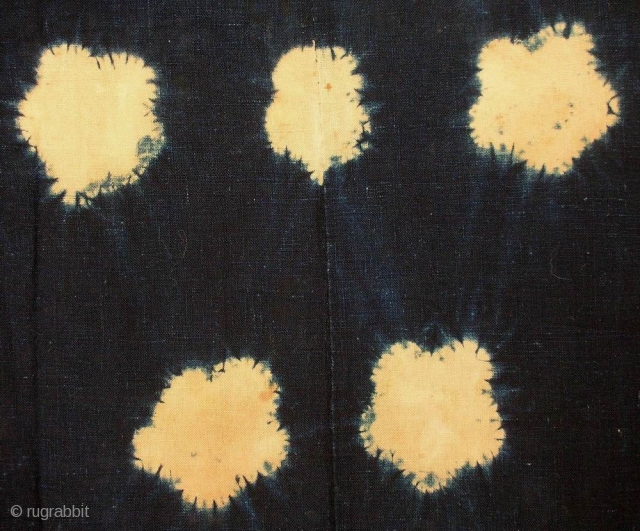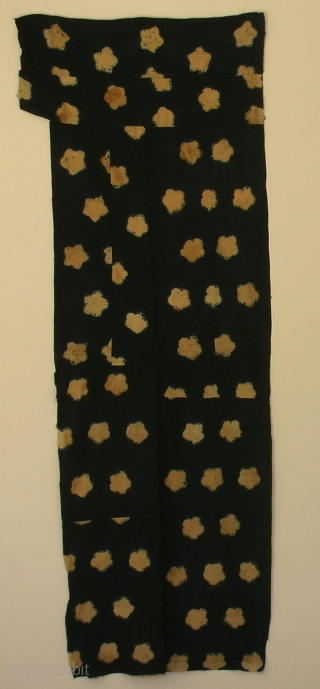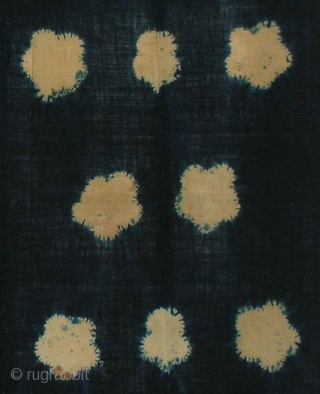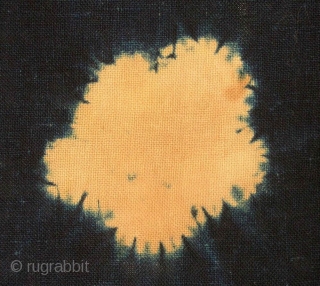Back
‘Ume blossom’ large shibori cloth , Japan, late Edo (c.1850), 166x61cm. The common English translation of the Japanese word shibori is "tie-dye"; however, a more accurate translation is "shaped-resist dyeing," which describes the inherent patterning process of manipulating the two-dimensional cloth surface into three-dimensional shapes before compressing them to dye. Here we have a quite early (mid-19th century) cloth of hand-spun and hand-woven cotton, tie-dyed to obtain a sequence of ‘ume’ (Japanese apricot) blossoms. The flower, long a beloved subject in the traditional painting of East Asia and Vietnam, is usually 'translated' as plum blossom. Ume blossoms are often mentioned in Japanese poetry as symbol of spring. The cloth itself, has a very soft touch and is made up from nine smaller fabrics, sewn together to obtain what looks to be a sort of curtain. What impresses, however, is the outstanding quality of the indigo dye, that makes the ‘blossoms’ like glowing on it. Condition is good, with just bit of ‘foxing’ due to age. Truly a lovely thing.
price:
SOLD
- Home
- Antique Rugs by Region
- Category
- Profiles
- Post Items Free
- Albums
- Benaki Museum of Islamic Art
- Budapest: Ottoman Carpets
- Gulbenkian Museum
- Islamic Carpets. Brooklyn
- Islamic Textiles. Brooklyn
- Konya Museum: Rugs
- MKG, Hamburg
- MMA: Caucasian Carpets
- MMA: Mamluk Carpets
- MMA: Mughal Indian Carpets
- MMA: Ottoman Carpets
- MMA: Safavid Persian Carpets
- MMA: Turkmen Rugs
- McCoy Jones Kilims
- Ottoman textiles. Met
- Philadelphia Museum
- Rugs and Carpets: Berlin
- Seljuqs at the Met
- TIEM, Istanbul: Carpets
- V&A: Classical Carpets
- Vakiflar Carpets: Istanbul
- Baluch Rugs: Indianapolis
- Gallery Exhibitions
- Jaf an Exhibition
- Alberto Levi Gallery
- Andean Textile
- Christie's London: 2016
- Francesca Galloway
- HALI at 40
- ICOC Washington, DC 2018
- Jajims of the Shahsavan
- London Islamic Week April, 2018
- Mongolian Felts
- Navajo Rugs: JB Moore
- Persian Piled Weavings
- SF Tribal & Textile Art Show 2020
- SF Tribal 2019
- Sotheby's: C. Alexander
- Turkish Prayer Rugs
- Turkmen Main Carpets ICOC 2007










